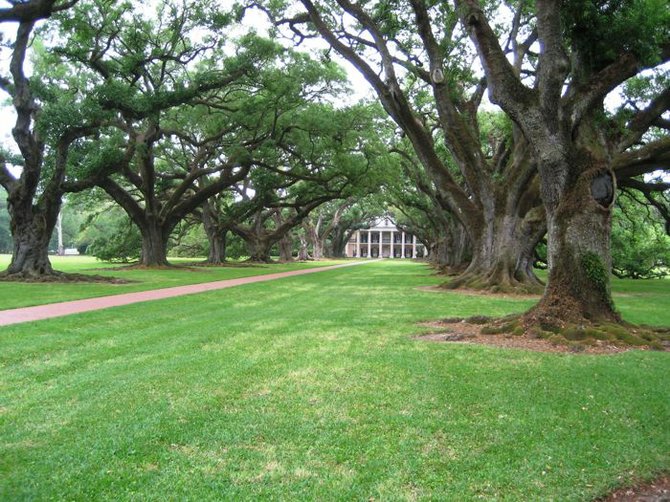 Facebook
Facebook
 X
X
 Instagram
Instagram
 TikTok
TikTok
 Youtube
Youtube

The thing about bayous is that they are humid, wet places. Very wet places. The trees that grow there know it. The things that live there know it. I knew it, too. Know it still. Bayous drip. Another thing about bayous is that they are musical places. They sing to you all night long, in full chorus. There’s more to a bayou than frogs and crickets.
After spending the afternoon touring a classic antebellum mansion, we’d camped at Sam Houston Jones State Park in a bayou, giving me a great appreciation for the people who live in (or rather, on) the bayou. All along the old River Road snaking along the Mississippi between New Orleans and Baton Rouge, plantations once thrived a stone’s throw from the river’s edge.
Somewhere between the water and the land, the French Creole elite built country estates along the river. Plantation homes of all shapes and sizes. Some were constructed of simple clapboard. Others were made of double-wall, thick slave-hewn bricks.
Oak Alley, however, is not called the Grande Dame of the Great River Road for nothing. Set back behind a quarter-mile avenue lined with magnificent 300-year-old grandmother oaks stands the classic Greek-Revival style antebellum mansion owned by none other than the man known as the Sugar King of Louisiana.
We stopped in for a tour and learned that aside from the imported roof slate and marble used for the floors and fireplaces, the materials for the construction of the mansion had all either been found or made on site. Interestingly, this prominent family spent $400 a week to have ice chunks shipped down the Mississippi from the north in order to preserve delicacies such as dairy, which was buried in the cool earth in large terra-cotta olive crocks away from the hot, humid climate. We spied just a single window with the diamond etching of a bride-to-be – the tell-tale signature of an authentic antebellum mansion.
Spending a leisurely afternoon beneath the trees, communing with the awesomeness of nature and time, we sipped our first mint julep. We later ate lunch at the onsite café, where I sampled alligator, which seemed like the right thing to do at the time.
Like so many Southern plantations, this refined family eventual auctioned their beloved 1,360-acre estate and all their personal belongings in order to survive the post-Civil War turmoil that resulted from the Reconstruction Act. And like anything else left unattended in the bayou, all that was polished and refined was soon consumed and reclaimed by the wild. Cattle, birds and snakes took up residency in the marble halls of Oak Alley, until it was later restored to its original grandeur.


The thing about bayous is that they are humid, wet places. Very wet places. The trees that grow there know it. The things that live there know it. I knew it, too. Know it still. Bayous drip. Another thing about bayous is that they are musical places. They sing to you all night long, in full chorus. There’s more to a bayou than frogs and crickets.
After spending the afternoon touring a classic antebellum mansion, we’d camped at Sam Houston Jones State Park in a bayou, giving me a great appreciation for the people who live in (or rather, on) the bayou. All along the old River Road snaking along the Mississippi between New Orleans and Baton Rouge, plantations once thrived a stone’s throw from the river’s edge.
Somewhere between the water and the land, the French Creole elite built country estates along the river. Plantation homes of all shapes and sizes. Some were constructed of simple clapboard. Others were made of double-wall, thick slave-hewn bricks.
Oak Alley, however, is not called the Grande Dame of the Great River Road for nothing. Set back behind a quarter-mile avenue lined with magnificent 300-year-old grandmother oaks stands the classic Greek-Revival style antebellum mansion owned by none other than the man known as the Sugar King of Louisiana.
We stopped in for a tour and learned that aside from the imported roof slate and marble used for the floors and fireplaces, the materials for the construction of the mansion had all either been found or made on site. Interestingly, this prominent family spent $400 a week to have ice chunks shipped down the Mississippi from the north in order to preserve delicacies such as dairy, which was buried in the cool earth in large terra-cotta olive crocks away from the hot, humid climate. We spied just a single window with the diamond etching of a bride-to-be – the tell-tale signature of an authentic antebellum mansion.
Spending a leisurely afternoon beneath the trees, communing with the awesomeness of nature and time, we sipped our first mint julep. We later ate lunch at the onsite café, where I sampled alligator, which seemed like the right thing to do at the time.
Like so many Southern plantations, this refined family eventual auctioned their beloved 1,360-acre estate and all their personal belongings in order to survive the post-Civil War turmoil that resulted from the Reconstruction Act. And like anything else left unattended in the bayou, all that was polished and refined was soon consumed and reclaimed by the wild. Cattle, birds and snakes took up residency in the marble halls of Oak Alley, until it was later restored to its original grandeur.
Comments